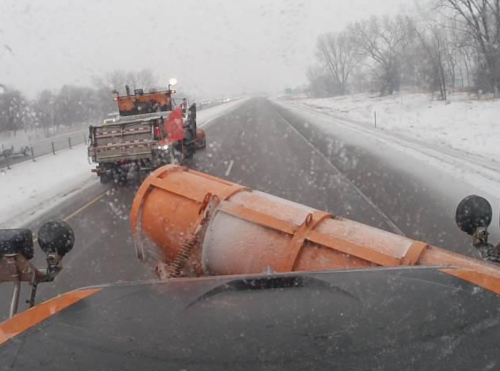The Minnesota Department of Transportation is testing technology deployed on 10 of its snowplows that allows operators to activate digital highway signs to warn motorists when slow-moving vehicles are ahead on the road.
[Above photo by the Minnesota DOT.]
Operators of those snowplows – deployed on Interstate 35 in southern Minnesota – can use the technology to activate digital message signs to display certain messages as they pass, such as: “Snowplow ahead, use caution” or “Maintenance vehicle ahead, use caution” during non-snow events. The message stays activated for several minutes after the snowplow passes the sign.

“Alerting motorists that they’re approaching a slow-moving snowplow can improve safety for our operators and motorists,” said Ron Heim, a Minnesota DOT maintenance supervisor, in a statement. “We are focused on safety and we think this use of technology will help everyone on the road.”
[Want to know more about snow and ice fighting tactics? Check out the winter operations podcast put together by the American Association of State Highway and Transportation Officials Snow and Ice Pooled Fund Cooperative Program, known as “SICOP.”]
The agency explained that snowplows can create “snow clouds” when clearing roads at slower speeds and data gathered over the past few years indicates that many crashes involving snowplows are rear-end collisions when motorists strike the back of the snowplow. This technology and warning system could reduce and prevent these types of crashes in the future, the Minnesota DOT said.

The agency added that it plans to evaluate this sign-messaging technology to determine its potential use for other operations, added Jed Falgren, Minnesota DOT’s state director for transportation system management and operations.
“Our trucks are already providing data, so we’re able to build off of that and test this concept,” he said. “We can improve safety and this an important test that should show us what can come next.”
This pilot project is part of Minnesota DOT’s connected and automated vehicle or CAV research to understand how advancing technology can improve safety, emphasized Michael Kronzer, project manager and head of strategic partnerships for the agency’s CAV-X office.
“This project illustrates one element in a broad range of CAV initiatives and the potential these technologies hold,” he said. “CAV is so much more than just automated vehicles and Minnesota DOT is interested in helping lead the state to learn, integrate and understand how technology can improve our transportation system, equity, accessibility and safety.”
 States
States


